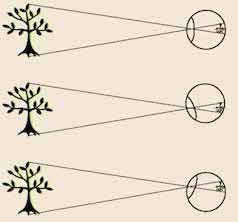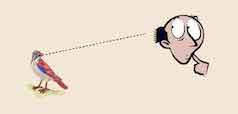Spatial locations are defined in a frame of reference. A frame of reference is the reference point or axes used to describe where something is. How do our brains define the locations of objects? This depends on the kind of object. If the object is visible, then our eyes will report its location to the brain in an eye-centered frame of reference. The frame of reference is eye-centered because of the optics of the eye - to reach the retina, light must pass through the pupil, and individual photoreceptors at a particular spot on the retina can only "view" the location in the visual scene that is lined up with the pupil for that position on the retina. This is why photoreceptors have receptive fields - they can only be affected by light coming from a very restricted region of the visual environment. When the eye moves, the location in the environment that an individual photoreceptor views moves as well.
This shifting frame of reference poses a variety of problems. First, the stability of visual perception: how do we maintain a sense of where things are when the eyes are constantly moving? Second, memory: how do we compare what we see now with what we saw at
some earlier point in time despite the eyes having moved in the meantime?
And there is a third problem. The visual system is not our only sensory system. Our auditory and somatosensory systems also provide information about external objects and events, and these two senses use different frames of reference. For example, receptors on the skin report where on the skin a tactile stimulus is located - a body-surface centered frame of reference. The eyes and body can move with respect to one another, so there is no fixed correspondence between the visual eye-centered and somatosensory body-surface centered reference frames.
The auditory system calculates the locations of sounds using minute differences in sound arrival time and loudness across the two ears, as well as subtle filtering of the frequency content by the folds of the ears. These cues can be used to infer the direction a sound is coming from, defined with respect to the ears. Since the ears are attached to the head, and immobile, this reference frame is referred to as a head-centered reference frame.
So the third problem is how can the brain integrate or combine information from different sources when the spatial reference frames are different?
 When the eye looks straight ahead, the image of the tree falls in the center of the retina.
When the eye looks straight ahead, the image of the tree falls in the center of the retina.
When the eye looks up or down, the image of the tree shifts to a different location on the retina. The retina signals the locations of stimuli in an eye-centered frame of reference.
 The visual and auditory components of stimuli are encoded in different reference frames. The sound of the bird is to the right in a head-centered reference frame - the sound is louder and arrives sooner to the right ear. But if the eyes are turned to the right, then the image of the bird is in the center in an eye-centered reference frame. The relationship between a location defined with respect to the head and a location defined with respect to the eyes depends on the orientation of the eyes with respect to the head.
The visual and auditory components of stimuli are encoded in different reference frames. The sound of the bird is to the right in a head-centered reference frame - the sound is louder and arrives sooner to the right ear. But if the eyes are turned to the right, then the image of the bird is in the center in an eye-centered reference frame. The relationship between a location defined with respect to the head and a location defined with respect to the eyes depends on the orientation of the eyes with respect to the head.
Research in the Groh laboratory is devoted to addressing these questions. We have designed models for coordinate transformations (transforming from one reference frame to another). We have found evidence for conversion of auditory and somatosensory signals into an eye-position dependent reference frame. Our recent experiments have explored the coding of auditory space at several stages of the auditory pathway, and have suggested that coordinate transformations begin much earlier in the neural hierarchy than was previously suspected. Our results suggest that integration of visual and auditory information may occur in a composite or hybrid reference frame that reflects both head- and eye-centered components of the locations of stimuli
So what do Copernicus and your brain have in common? Well, like your brain, Copernicus solved a frame of reference problem. Astronomers had puzzled for centuries about the strange trajectories of the other planets in our solar system. Copernicus realized that the planets were all moving around the sun, and not the earth, which had made the planetary trajectories seem quite confusing. Later, Kepler determined that these orbits followed a highly predictable elliptical trajectory around the sun. A sun-centered, or heliocentric, view of the solar system, emerged.